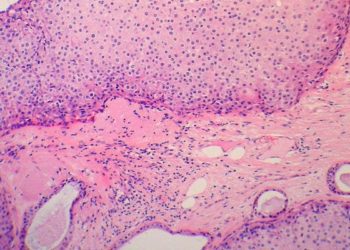Omission of axilla surgery is non-inferior to sentinel lymph node biopsy in female patients with small breast cancers and clinically negative axillary lymph nodes
1. 5-year distant disease-free survival was comparable between both groups.
2. 5-year overall survival was similar between groups.
Evidence Rating Level: 1 (Excellent)
Study Rundown: In patients with early breast cancer, the standard of care for axillary node staging is the sentinel lymph node biopsy (SLNB). This noninferiority study examined whether omitting axillary surgery (like SLNB) resulted in worse outcomes as compared to the standard SLNB. The primary outcome of this study was 5-year distant disease-free survival (DDFS) and secondary outcomes included disease free survival (DFS) and overall survival (OS). The median follow-up period was 5.7 (5.0-6.8) years in the SLNB group and during this time there were 12 locoregional relapses, 13 distant metastases, and 21 deaths. In the non-surgery group the median follow-up period was 5.7 (5.0-6.6) years, and there were 11 locoregional relapses, 14 distant metastases, and 18 deaths. At 5-years, the DFS for the SLNB cohort was 94.7% and was 93.9% in the non-surgery cohort. The majority of patients were alive in both groups at 5-years: 98.2% in the SLNB cohort compared to 98.4% in the non-surgery group. Limitations to this study include that the criteria for enrollment recruited patients who may be at lower risk of recurrence during the study follow-up period. To address this limitation, this study has extended its follow-up period to 10 years, after which a formal analysis will be completed. Overall, the results from this study support avoiding axillary surgery in women whose breast cancer and treatment plans permit such an approach to management.
Click to read the study in JAMA Oncology
Relevant Reading: Breast-conserving surgery with or without irradiation in early breast cancer.
In-Depth [randomized controlled trial]: This study was a phase 3, randomized clinical trial that analyzed data from 18 centres in multiple countries. 1,463 female patients with invasive breast cancer 2cm diameter or smaller and an absence of axillary node involvement on ultrasound were enrolled in the study. Patients were randomized in a 1:1 fashion to receive either SLNB (n = 727) or no surgery (n = 736). 1,405 patients were analyzed in the intention-to-treat analysis (708 from the SLNB group, and 697 from the non-surgery group). In the SLNB group during the follow-up period, 1.7% of patients had a locoregional relapse, 1.8% experienced a distant metastasis, and 3.0% died; this is in comparison to 1.6%, 2.0%, and 2.6%, respectively, in the non-surgery group. The 5-year DDFS was 97.7% in the cohort that received SLNB, and 98.0% in the cohort that did not receive any axillary surgery. Based on the results for DDFS, the absence of axillary surgery is non-inferior to SLNB (hazard ratio, 0.84; 90% confidence interval (CI), 0.45-1.54)).
Image: PD
©2023 2 Minute Medicine, Inc. All rights reserved. No works may be reproduced without expressed written consent from 2 Minute Medicine, Inc. Inquire about licensing here. No article should be construed as medical advice and is not intended as such by the authors or by 2 Minute Medicine, Inc.







